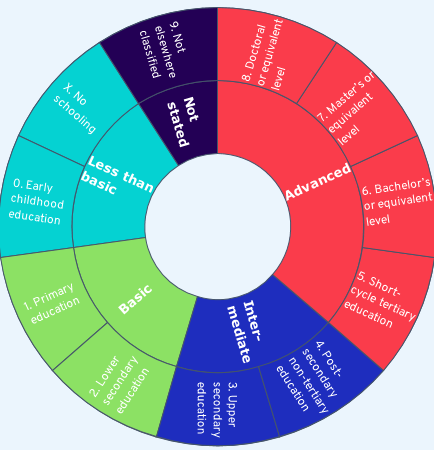This article summarizes the findings of our latest Spotlight on Work Statistics. For more information, check out the full brief.
Education is a crucial component of sustainable development. It is an enabler of economic growth, labour productivity, human capital gains and social mobility. In times of pandemic, decision-makers around the world had to rethink and re-organize education on the spot to ensure its continuation, and to minimize adverse effects on students, teachers, and communities.
Higher education allows workers to increase their skills, in the hope of getting better jobs in the future. But does education actually pay off? Are highly educated workers better off in the labour market?
Education is still a luxury in most of the world
Tertiary education is still a privilege available only to a minority. ILOSTAT data show that in most countries, the vast majority of the labour force has not completed any tertiary degree. The educational level of the labour force is linked to the level of national income: the richer the country, the higher the share of its labour force with a tertiary degree.
Encouragingly, the educational level of the labour force is increasing, with younger generations reaching higher educational levels than older generations.
Unemployment among highly educated workers: a big challenge in low-income countries
In pursuing advanced education, workers may expect to be better prepared for the labour market. They may expect to find a quality job without much delay. But this is not always the case: highly educated workers can find themselves unemployed, sometimes even for a long time.
To what extent does our educational level shield us from unemployment? Actually, in 82% of low-income countries and in 70% of lower-middle-income countries with data, the unemployment rate is higher for those with an advanced educational level than for those with only a basic educational level, while this is true in 31% of upper-middle-income countries and 16% of high-income countries.
In other words, highly educated people are much more likely to be unemployed in low-income countries than in high-income countries, especially compared to people with a basic educational level.
This finding is confirmed when comparing the proportion of people with an advanced educational level among the employed and the unemployed. The share of people with an advanced educational level is larger among the unemployed than among the employed (meaning that highly educated people are over-represented among the unemployed) in an astonishing 82% of low-income countries and only 10% of high-income countries. Likewise, the share of people with a basic educational level or less is larger among the unemployed than among the employed (meaning that people who have not reached upper-secondary education are over-represented among the unemployed) in only 9% of low-income countries, compared to a striking 84% of high-income countries.
Share of employed and unemployed with a given educational level (latest year available for each country)
Source: ILO Harmonized Microdata collection.
In short, in low-income countries, workers who struggle the most to find suitable jobs are those with an advanced educational level, while in high-income countries, it is those with a basic educational level or less. This could be related to differences in labour market structure and employment opportunities across countries. Are skilled or unskilled jobs more abundant? In low-income countries, skilled jobs may be scarce and there may be a mismatch between the skills required for jobs available and the skills of the jobseekers. Conversely, labour markets in high-income countries may have fewer unskilled jobs, making it more difficult for jobseekers with a basic educational level to find jobs there.
Nonetheless, this does not tell us anything about the circumstances of the unemployed, such as whether or not they are receiving unemployment benefits, the type of job search infrastructure they have access to, and their criteria to accept a job offer. Also, the higher unemployment rates of people with advanced education do not necessarily imply that they are worse off: it may be that they can afford to stay unemployed for longer than workers with basic or less than basic education. (For more information on what the unemployment rate does and does not tell us, check out our previous article and our Quick Guide).
It may take some time for highly educated workers to find a proper job in low-income countries, but once they do, what are the conditions of the job? The quality of employment is just as crucial as accessing employment. At least in low-income countries, education does not seem to be an effective shield against unemployment, but does it pay off in terms of job quality?
Highly educated workers are much more likely to be formal employees
Status in employment
Employed people can be classified according to their status in employment into employees and self-employed. The self-employed include employers, own-account workers and contributing family workers. Since employees generally benefit from better working conditions, the share of employees in total employment (also known as the paid employment rate) provides a glimpse into the working conditions of the employed population. It is a proxy indicator of employment quality.
The impact of the workers’ educational level on their chances of being in paid employment is glaring. In the vast majority of countries with data (87%), the share of employees is higher among people with an advanced educational level than among those with a basic or less than basic educational level. In fact, workers with an advanced educational level have a very high tendency to be employees: in all countries with data except for two (Solomon Islands and Togo) the paid employment rate of workers with advanced education exceeds 60%.
Source: ILO Harmonized Microdata collection.
What is most striking here is the gap between the paid employment rate of persons with advanced education and that of persons with basic or less than basic education. Paid employment is the norm in high-income countries in general, so in those countries, paid employment rates are high for all workers. Thus, in high-income countries, the gap in paid employment rates across educational levels is smaller (in the chart, markers for high-income countries are concentrated around the bisector and in the top right quadrant). Conversely, in low-income countries, paid employment is much less common, and workers with a basic or less than basic educational level rarely manage to secure paid employment jobs. However, in low-income countries, highly educated workers are as likely to be employees as they are in high-income countries (which is very likely). Put another way, in low-income countries, people with an advanced educational level have a bigger premium in terms of working conditions (in the chart, markers for low-income countries are concentrated in the bottom right quadrant).
Informality
Another key aspect of job quality is whether the job is formal or informal. Informal jobs are outside the scope of countries’ labour legislation, which puts workers at a higher risk of vulnerability.
Our data show a strong correlation between the educational level of the workforce and the likelihood of workers to access formal jobs. In all countries with available data (regardless of their level of national income), workers with advanced education have much lower informality rates than workers with a basic or less than basic educational level. That is, in poor and rich countries alike, education seems to facilitate workers’ access to formal jobs.
Furthermore, given that informality is more prevalent overall in low-income countries, once again, that’s where highly educated workers have a bigger premium in terms of working conditions compared to workers with a lesser educational level.
But the status in employment and the formal or informal nature of jobs only give us an overall idea of job quality. What about the more concrete working conditions, such as earnings and working time?
Highly educated workers are more likely to have sufficient working time and adequate earnings
Working time
Difficulties in securing sufficient hours of work may put workers and their families in a strenuous situation. What our data show is that, around the world, this happens more often to workers who have not completed upper-secondary education.
Generally speaking, the higher a worker’s level of educational attainment, the higher their average usual hours of work per week. What is more, this seems to be true around the globe, regardless of the country’s level of income. In the majority of countries with available data (70%), it is workers with either an advanced or an intermediate educational level who usually work the most hours per week on average. Furthermore, in 68% of countries with data, workers with a basic or less than basic educational level usually work the fewest hours per week.
Earnings
The ratio of earnings of workers with an advanced educational level to those of workers with a basic educational level gives us a clear idea of how the earnings of those two groups of workers compare. We can produce this ratio for employees in 79 countries, and in all of them but 3 (Ghana, Liberia and Sudan), employees with an advanced educational level earn on average more than those with a basic educational level. We can also produce this ratio for self-employed in 46 countries and in all of them but 3 (Comoros, Italy and Samoa), self-employed workers with an advanced education earn more on average than those with a basic education.
Education in times of pandemic
The COVID-19 pandemic had an immediate and massive impact on the education sector. It forced decision-makers around the world to take action to contain the spread of the virus, leading them to rethink and reorganize formal and non-formal education on the spot. In a vast number of countries, teachers and students at all levels were required to turn to virtual lessons and online learning. Remote teaching is being applied at an unprecedented scale.
It is probably still too early to assess the full extent of the pandemic and the measures to combat it on teachers, students and the quality of education. However, it is clear that the lessons learned during this unusual time have to be carefully considered for future improvements.
Concluding remarks
In low-income countries, highly educated workers may find it more difficult to find a suitable job since skilled jobs are scarce, but once they do, chances are that it will be a quality job. They may envy the lower unemployment rates of less educated workers, but this is certainly compensated in terms of job quality. Indeed, highly educated workers tend to earn more, work more hours and have a higher likelihood of being formal employees.
Conversely, in high-income countries, workers who do not even have an upper-secondary degree are more exposed to both unemployment and job quality deficits. They are more likely to be unemployed than highly educated workers, and when employed, they are less likely to be in formal paid employment.
Nonetheless, it is necessary to highlight that correlation does not imply causation. In general terms, the higher a worker’s educational level, the better their working conditions (especially in terms of status in employment, formality, working time and earnings). But this does not necessarily mean that it is solely the advanced educational level of highly educated workers which leads to their improved working conditions. There may be other factors at play, and there may be common factors driving both workers’ educational level and their employment quality.
The categories of educational attainment mentioned in this article are based on the 2011 International Standard Classification of Education, as shown here:

Author
-
Rosina Gammarano
Rosina is a Senior Labour Statistician in the Statistical Standards and Methods Unit of the ILO Department of Statistics. Passionate about addressing inequality and gender issues and using data to cast light on decent work deficits, she is a recurrent author of the ILOSTAT Blog and the Spotlight on Work Statistics. She has previous experience in the Data Production and Analysis Unit of the ILO Department of Statistics and the UN Resident Coordinator’s team in Mexico.












